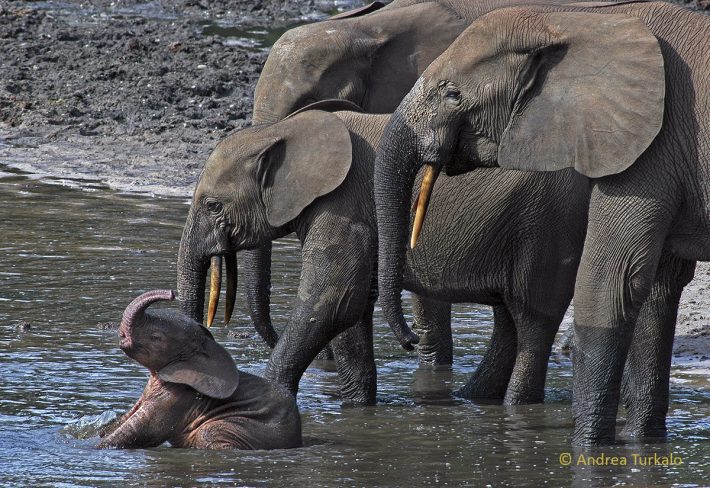Press Release: Forest elephants among the world’s slowest reproducing mammals, spelling trouble for populations threatened by poaching
Save the Elephants Press Release
Forest elephants are one the slowest reproducing mammals in the world, according to the first ever study of their demography. The findings, published in the Journal of Applied Ecology, indicate it will take almost a century to recover from the poaching they have suffered since 2002.

Forest elephants among the world’s slowest reproducing mammals, spelling trouble for populations threatened by poaching
Because forest elephants are one the slowest reproducing mammals in the world, it will take almost a century for them to recover from the intense poaching they have suffered since 2002. Not only does it take more than two decades for female forest elephants to begin reproducing, but they also give birth only once every five to six years.
The findings are from a first-ever study of forest elephant demography published Aug. 31 in the Journal of Applied Ecology.
There are two species of elephants in Africa. Savannah elephants make up the majority across the continent, with smaller numbers of the more diminutive forest elephants restricted to tropical forests. Forest elephants have experienced serious poaching, driving an estimated population decline of 65 percent between 2002 and 2013.
Their reported low birth rates mean that it will take forest elephants at least 90 years to recover from these losses, according to researchers from the Wildlife Conservation Society, the Cornell Lab of Ornithology’s Elephant Listening Project, Colorado State University, and Save the Elephants. The team used decades of intensive monitoring data that recorded births and deaths of the elephants using the Dzanga Bai in Central African Republic, part of the UNESCO World Heritage Sangha Trinational area. (Dzanga Bai translates roughly as “village of elephants.”)
“This work provides another critical piece of understanding regarding the dire conservation status of forest elephants,” said Andrea Turkalo, the Wildlife Conservation Society scientist who over several decades collected the detailed data on the Dzanga elephants despite tough logistical challenges and political instability.
Using data Turkalo collected from 1990 to 2013 during nearly daily visits to a mineral rich forest clearing, or bai, that attracts elephants and other wildlife, the authors were able to uncover the age at which the forest elephants had their first calves, the length of time between calves, and other behaviors.
The team found that forest elephants begin breeding later and have much longer calving intervals than other elephants, which means the population takes much longer to increase.
“Female forest elephants in the Dzanga population typically breed for the first time after 23 years of age, a markedly late age of maturity relative to other mammals,” Turkalo said. “In contrast, Savannah elephants typically begin breeding at age 12. In addition, breeding female forest elephants only produced a calf once every five or six years, relative to the three- to four-year interval found for Savannah elephants.”
The authors believe that the low birth rate is due to the challenges of living in a tropical forest, where new plant growth is mostly limited to the canopy.
“While we think of tropical forests as incredibly productive areas, most production occurs in the high canopy inaccessible to ground-dwelling species,” said Peter Wrege, a behavioral ecologist at the Cornell Lab of Ornithology’s Elephant Listening Project. “In addition, vegetation in tropical systems are laden with compounds to defend their leaves from herbivores, including elephants. This means accessing resources is challenging for terrestrial fauna.”
George Wittemyer, chair of the Scientific Board of Save the Elephants and a professor in Wildlife Conservation at Colorado State University, said the findings are essential to assessing the status of forest elephants and projecting population decline in the face of illegal killing. “Legislation regarding ivory trade must consider the collateral effects on forest elephants and the difficulties of protecting them,” he said. “Trade in ivory in one nation can influence the pressures on elephants in other nations.”
The paper’s findings show that the forest elephant is particularly susceptible to poaching, vital information for debates and upcoming policy legislation on the legality of ivory trade, which will be decided at the Convention on International Trade in Endangered Species in late September.
The authors also highlight the importance of the results for interpreting carcass data collected through the Monitoring of Illegal Killing of Elephants program, which has shown high levels of poaching across central Africa.
“Only by understanding the basic biology of forest elephants and other species, can we properly determine the level of threats they face from human activities,” said Wittemyer.
Forest elephants have critical ecological roles in these forests, and many tree species rely on the elephants to disperse their seeds. Continued decline in forest elephant numbers and range is likely to drive severe changes to these ecosystems, making their conservation status a significant global issue.
Failing to protect forest elephants would also damage Central African forests, which are important for absorbing climate change gases.
Andrea Turkalo, Peter Wrege and George Wittemyer (2016), ‘Slow intrinsic growth rate in Forest Elephants (Loxodonta cyclotis) indicates recovery from poaching will require decades’, doi: 10.1111/1365-2664.12764, is published in Journal of Applied Ecology on Wednesday, 31, August 2016.
Like what we stand for?
Support our mission and help develop the next generation of ecologists by donating to the British Ecological Society.